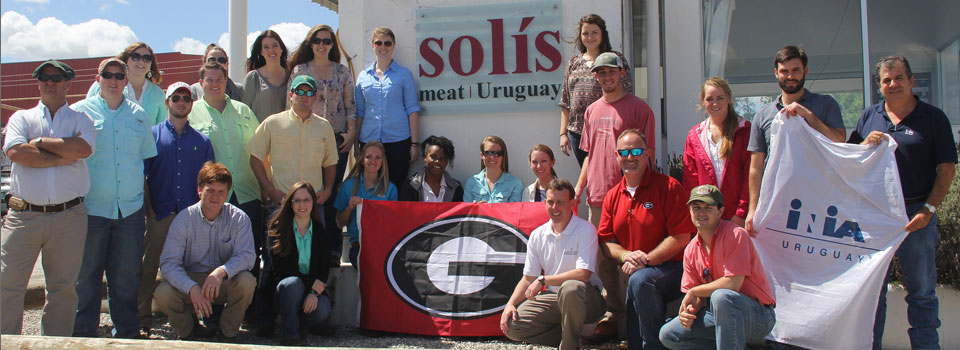Where’s the beef?
For University of Georgia students looking to learn about grass-fed beef and novel approaches to cattle farming, it’s in Uruguay, where there are three cows for every person and farmers have built a thriving export industry based around sustainable cattle ranching.
The Uruguay: Sustainable Beef and Grain Production and Marketing Systems program offers students in UGA’s College of Agricultural and Environmental Sciences three credit hours for a 10-day spring study abroad trip to the South American country.
Curt Lacy, a professor of agricultural and applied economics who focuses on beef markets, organized and led the trip and calls Uruguay the perfect classroom for students interested in learning about how consumers’ demand for grass-fed beef is affecting American markets.
“There is a growing demand from consumers looking for food products that are raised primarily on forages, without antibiotics and added hormones,” Lacy said. “To meet this increased demand there are many cattle producers and CAES students that would like to raise cattle from pasture to plate using this approach.”
The program was designed to show students what these systems look like in the real world and to show that while it can be done, raising cattle this way is not as easy as a lot of people think, Lacy said.
“Because Uruguay is very similar to much of Georgia in terms of climate and forages they can grow, Uruguay provides an excellent opportunity to learn firsthand about what works and doesn’t work when it comes to forage-based livestock systems,” he said.
For the past two years, UGA agricultural economists Lacy and Nathan Smith, who researches the economics of field crops, have led students on a spring break trek to the South American country.
“It was a great opportunity for students to experience a beautiful country, different culture and different production practices,” Smith said. “(We) saw a range of different operations from large to small-and how Uruguayan farmers utilize their resources to meet global demand.”
The students toured pasture-based dairies, cattle ranches, sheep ranches, a beef packing plant, rice, soybean and wheat farms, a rice-milling plant, an olive orchard and agricultural experiment stations. They were hosted in large part by UGA alumni now working at the Instituto Nacional de Investigacion Agropecuria, Uruguay’s National Institute for Agricultural Research.
In addition to learning about Uruguay’s agricultural practices and global trade, the students learned about the country’s culture, which is rooted in farmland and draws on European and Latin influences.
“At a place like Las Palmas, it’s easy to believe that you’ve stepped back in time a hundred years,” said Will Thompson, a graduate student in agricultural and applied economics who was one of the first students to participate in the study abroad program. “However, ranchers are using cutting-edge genetic scoring and animal husbandry techniques to make themselves competitive in the global market.”
Farmers in Uruguay have melded traditional farming practices with cutting edge genetic scoring and animal husbandry techniques that have helped their cattle dominate parts of the global market.
Uruguayan farmers realized early that tracking cattle from birth to retail product would help alleviate international fears about cattle diseases, and they have tagged every cow in every herd since 2006. This allows agricultural agents to track a disease outbreak back to its source and keep it from spreading.
Uruguayan herds are foot and mouth disease-free thanks to biannual vaccinations, and the country has never experienced an E. coli outbreak connected to beef. All of their herds are raised without antibiotics, additional growth hormones, and they predominantly eat grass and roam the land at leisure.
These are traits Americans are starting to demand from their cattle herds, and UGA’s animal science researchers are hoping to work with their former colleagues and students in Uruguay to develop a comprehensive joint research program.
This year UGA and the INIA renewed their agreement to encourage future collaboration between the organizations on research and education exchange programs.
“For several years, there has been considerable collaboration between UGA and INIA, especially in the areas of animal and crop sciences,” Lacy said. “With the renewal of this agreement, we are hoping to build on these past successes. Obviously, in addition to continuing the very strong animal and crop science collaborations we have enjoyed, we want to continue the study abroad program as all of the past participants have indicated it was very educational and fun.”
Other potential collaborations might include hosting farmer delegations from Uruguay, evaluating the economics of new production technologies that are of interest to both countries and analyzing data from the Uruguayan farmer-benchmarking program, he added.
Benchmarking is where farmers compare the efficiency of their farm to surrounding farmers in order to improve their production systems. “The farmer benchmarking also has great potential for farmers here in the U.S.,” Smith said. “(The program’s) peer groups have visited the U.S. in the past. We would like to explore the idea of peer groups here where farmers use farm records to improve management and efficiency.”
This program and many other study abroad programs offered through the UGA College of Agricultural and Environmental Sciences are supported by the CAES Deans’ Promise program, which provides institutional and monetary support to CAES students seeking to gain real world experience in their fields of study.
-Merritt Melancon
